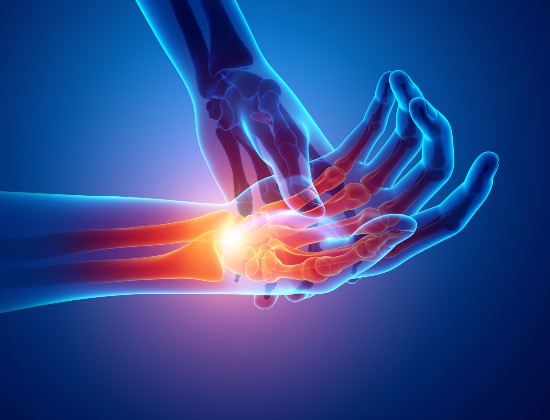Osteoarthritis (OA) of the wrist
A lubricating layer known as articular cartilage covers the ends of the bones in the wrist, and this helps to minimise friction within the joint. OA is pain and irritation of the cartilage in the joints of the wrist which, if it’s not treated, can cause more pain and limit movement.
Causes
As cartilage wears out, the rough surfaces of the bones begin to rub against one another and the hand becomes painful, stiff and inflamed. OA usually develops after many years of use, which is why it normally affects people who are middle-aged or older. However, it’s also more likely when there has been previous damage to the joint surface, for example a fracture or ligament injuries, and can also develop as a result of Kienböck’s disease.
Symptoms
These include pain, especially after working the joint, which becomes worse over time. This can make simple everyday activities more difficult. The joint can also swell and feel warmer and may ‘grate’ when it’s moved, or feel unstable.
Diagnosis
A medical examination and discussion of your symptoms is usually backed up by an X-ray, blood tests and, in some cases, (for example, if the specialist thinks you may have Kienböck’s disease), an MRI scan, or a bone scan which can show signs of arthritis that can’t be seen on an X-ray.
Treatment
Treatment will depend on a number of factors including your medical history, age, how far arthritis has progressed, your personal goals and the results of diagnostic imaging tests.
Non-operative treatment: this includes anti-inflammatory medications (if advised by your doctor) which can help to control the symptoms if the OA is in its early stages. Steroid injections can also help reduce pain and inflammation, especially if you also wear a splint to support the joint when you’re using the hand. You may also be advised to limit or stop activities that make your pain worse, although following a specific exercise plan can help improve movement in the wrist.
Surgery: if non-operative treatment doesn’t relieve your symptoms, you may be advised to have surgery to remove the three carpal bones (a proximal row carpectomy) which should help to relieve pain while still allowing you to have some limited wrist movement. If your OA is more advanced you may need to have partial joint fusion (where the carpal bones are fused together) or complete joint fusion (which also includes the radius) to reduce pain. However, these procedures will reduce your range of movement. In some cases you may be advised to have joint replacement surgery, which may help you to retain your wrist movement.
Important: This information is only a guideline to help you understand your treatment and what to expect. Everyone is different and your rehabilitation may be quicker or slower than other people’s. Please contact us for advice if you’re worried about any aspect of your health or recovery.


